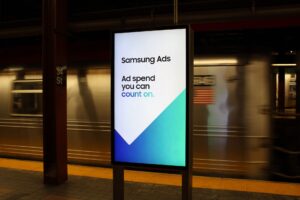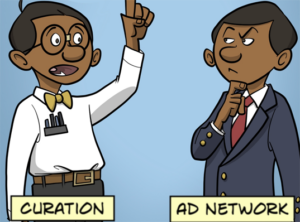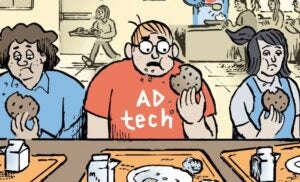Good news for the skeptics: 2025 will hopefully be a year of more practical AI use cases for advertising, especially as agencies get more hands-on with the tech.
The more access to AI agency employees get, the more integrated it will become into the advertising industry, said Nicole Perrin, an analyst and VP of business intelligence at Advertiser Perceptions.
Meanwhile, the number of advertisers who use AI tools already increased since 2023, from 56% to 68%, according to a survey conducted by Advertiser Perceptions in October.
And the number of advertisers who mostly or completely trust AI-powered ad tech to make campaign decisions without human oversight is also up, from one in four to nearly half.
Goodbye, chatbots?
Still, advertisers need to better understand what AI can actually do before taking a real leap – which means looking beyond the most hyped-up products now available.
Chatbots like ChatGPT and Microsoft Copilot and programs like Dall-E for images and Sora for video are a good way for advertisers to get their feet wet, said Amol Waishampayan, chief product officer at ad planning and activation platform fullthrottle.ai.
Similarly, most direct consumer interactions with AI have also been in this area, whether via communicating with a company’s chatbot (sometimes with disastrous results, as Air Canada learned earlier this year) or asking a tool to write an email for them.
But it’s long past time for advertisers to move on and embrace more sophisticated and pragmatic uses for AI, added Waishampayan.
“I would love to shed what I think is very superficial value,” he said, and evolve toward stronger integrations of AI into media buying, planning and measurement technology.
In the meantime, though, beyond AI-generated text for email subject lines, for example, or calls to action, there appears little desire to hand anything other than bottom-funnel messaging over to bots.
Human-created content in any form “holds more authenticity,” said Akaash Ramakrishnan, co-founder of creative optimization platform AdSkate. He even went so far as to suggest that a desire for that kind of authenticity may cause large language models to get “phased out” of some common text-based use cases somewhere down the line.
Alex Collmer, VidMob’s CEO and founder, put it more bluntly: “Why should I be bothered to read something that you weren’t bothered to write?”
Getting specific (but not too specific)
Chatbots aside, AI has already been part of the ad tech world for the better part of a decade.
Unfortunately, though, there’s a tendency to lump all automated tools together into one big bucket.
Yet it’s important to make a distinction between “AI” and “ML,” or machine learning, said Wil Schobeiri, CTO of persona-based targeting company Ogury.
Machine learning is a computer’s ability to identify patterns without supervision at scale or with a computational intensity that wouldn’t be possible for humans to accomplish alone, he said, whereas AI is simply “a marketing term now.”
Not that practical business use cases for both machine learning and generative tech aren’t emerging.
Ad tech companies have mainly embraced natural language processing capabilities as a way to generate strategic recommendations based on internal company data or audience personas.
And according to Advertiser Perceptions, advertisers are already using AI to target audiences more effectively (58%) and personalize ads (49%). Fifty-two percent use AI to inform marketing strategy decisions, up significantly from 2023.
AI also has the most potential to boost creative performance, help with post-click optimization and mitigate “undifferentiated heavy lifting,” Schobeiri said, meaning essential, high-volume tasks that don’t require human intervention – busy work, in other words.
However, even with these more specific use cases, advertisers should be careful not to go overboard on AI.
For example, there’s no point spending a ton of time, money and computing power to personalize one-to-one consumer experiences, which would create “huge sustainability drawbacks,” Collmer said.
“We’re not actually all that different from each other,” he said. “There’s going to be a right level of personalization that gets you the results that you need as a marketer.”
Not all that’s generative is gold
Meanwhile, the ad tech world will also have to get more serious about AI’s current limitations – and the potential for bad faith actors to take advantage of it.
Schobeiri, for example, worries what generative tech, specifically LLMs, will do to exacerbate the proliferation of made-for-advertising websites.
“Advertisers and DSPs in the supply chain will start to struggle even more to identify whether the underlying content is high-value,” he said, meaning human-created content intended for more than just attracting programmatic ad spend.
Another ongoing problem will be generative AI’s penchant for “hallucinating,” the colloquial (and technically inaccurate) term for delivering patently false or made-up information.
“There are definite potential pitfalls for people who go all in on using and trusting AI for everything,” said Perrin, advocating a “trust but verify” approach.
Similarly, many of AdExchanger’s sources said they hope 2025 is the year that AI experts and companies collaborate more closely with regulators and also find better ways to self-regulate themselves as an industry.
More independent third-party resources would be especially useful. Today, “most agencies get their AI training directly from the companies selling them on AI in the first place,” Perrin said.
“There’s a question of who will emerge, if anyone, as a more trusted, neutral source of information on AI for our industry,” she said. “Until that happens, a lot of the conversation will ultimately be pretty vendor-driven.”

















